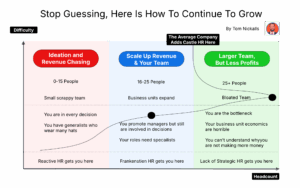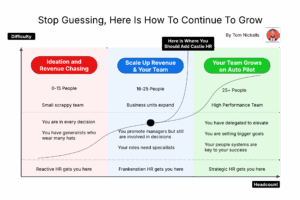In this blog, I will share Castle HR’s simplified strategies that lead companies to average 31% CAGR.
Let’s start with where you likely are today…
You grew a company from an idea to a team of over twenty people.
Of course, you’d assume you can keep doing what worked to grow further.
That’s logical.
But as you pass the 15–20 mark (and even well into the 20s, 30s, and 40s), a set of hidden constraints shows up: decisions pile up, managers struggle quietly, and profits get squeezed.

HBR’s article on The Five Stages of Small-Business Growth calls this “Stage 3 – Success”.
Growth often slows once you hit 20-25 people.
Not because you got worse, but because the game changed.
Top companies use simple strategies to average 31% CAGR to continue to scale.
Broken systems don’t always fail loudly; they can bleed your bottom line quietly.
If you’re nodding along, this article is for you.
It’s also why our average new client signs at 29.2: they feel the slowdown, try to push through, and finally acknowledge, “Okay, something needs to change.”
Here are some Quick Stats
Our average new client headcount is 29.2 employees.
Clients who stay with Castle for 2 years scale their headcount to 50+ on average.
That is on average ~71% total growth, about ~31% CAGR.
We accomplish this repeatedly with proven systematic systems, not tactics.
Here are Five Areas Fast Growing Companies Do Better
1) The founder is the bottleneck.
Every compensation change, every title tweak, every complicated conversation… still on your plate.
60+ hour weeks and yet you spent little time on your priorities because “fires” happened.
The result: Deliverables slip, not from apathy, but from decision debt.
You’re still the de facto HR strategist, and that stops working at 20+.
2) First-time managers without a playbook (and why they’re the multiplier).
You promoted your best people, which is a brilliant call. (Good to Great levels of trust.)
But yesterday’s top individual contributor is today’s first-time leader.
They are now running a business unit while building and running a team.
You probably see inconsistent performance and unit economics as bad.
82% of first-time managers fail.
What top companies do is give their managers tools, training, and systems, and they multiply output.
Deny them those, and business unit efficiency falls as headcount rises.
Which shows up on your bottom line.

3) More bodies, broken systems.
Your early duct tape and bubble gum systems held together at 10 people, but at 20+, they will break.
If your “systems” are vacation spreadsheets, random Notion docs no one uses, Slack approvals, and “loose” Google Doc policies with duplicates…
This is what we call the Frankenstein level, and you are setting your team up for failure.
These Frankensein systems don’t fail loudly; they chip away at your margins.
4) New hires expect grown-up operating systems.
Congrats, you have grown and can now attract top talent, usually people from established companies with a track record of success.
But, if you are posting for roles and not seeing the talent you expect to attract apply, that is a HUGE problem.
To get top talent to join (and stay), they must hear and see clean systems in HR, finance, ops and of course in their hiring process.
If your interview loop is fuzzy, if you can’t explain how you’ll put them in position to succeed, they won’t sign.
If they arrive and onboarding is “a laptop and a high-five”, they’ll bounce.
Meet them where they are, build a solid hiring and 90-day onboarding strategy for each role.
The time spent at the front will determine the results you get.
5) Culture by design, not by accident.
Up to ten people, values are kind of just “known.”
Once you pass 20 people, values must live on paper, in meetings, performance reviews, recognition, and hiring.
If you feel your people are making the wrong decisions when you aren’t in the room, then your values aren’t defined, or they aren’t adhering to them.
You want to formalize your winning behaviours so new people instantly learn “this is how we do things here.”
Top companies hold their values as high as KPIs. This is what EOS refers to as the “Right People.”
Tie them to behaviours that managers can reward or coach up.
Here is why you might be stalling in growth
The smoke signals happening between 20–30 often persist into the 30s and 40s if unaddressed: slower hiring, uneven onboarding, managers avoiding hard feedback, and projects that start and stall.
Most CEOs push through until the “slow” becomes a stall. That’s the 29.2 moment.

Waiting adds a rebuild tax: mis-hires, rework, manager burnout, culture drift.
Solving these earlier means you install systems before growth slows down, continuing your growth trajectory up and to the right.
All these challenges is precisely why Castle HR exists.
We solve this by adding a dedicated senior HR Pro to your team,
We only need one hour weekly to install the Modern HR OS without drowning your leaders.
How to Make Sure You Breakthrough Growth Plateaus?
Let’s chat. Book a 30-minute mapping session with the CEO of an award-winning HR company.
We will show you where you are today and tell you what you need to do to reach your goals.
If we can help, we will share how the first 30 days and our first 90-day sprint would go.
Still exploring?
Browse the Resource Centre to see how Canadian teams between 20-75 scale with Modern HR systems and review our pricing options here.

Tom Nickalls is the founder and CEO of Castle HR. Castle was launched in 2019 with the mission of helping businesses build high-performance teams by prioritizing culture, onboarding, and employee development. Since then, Castle has grown exponentially and empowered 100+ companies in Canada to scale smarter with modern, fractional HR service and strategy. Passionate about fostering strong workplace dynamics, Tom is dedicated to aligning business success with employee satisfaction in the ever-evolving world of work.